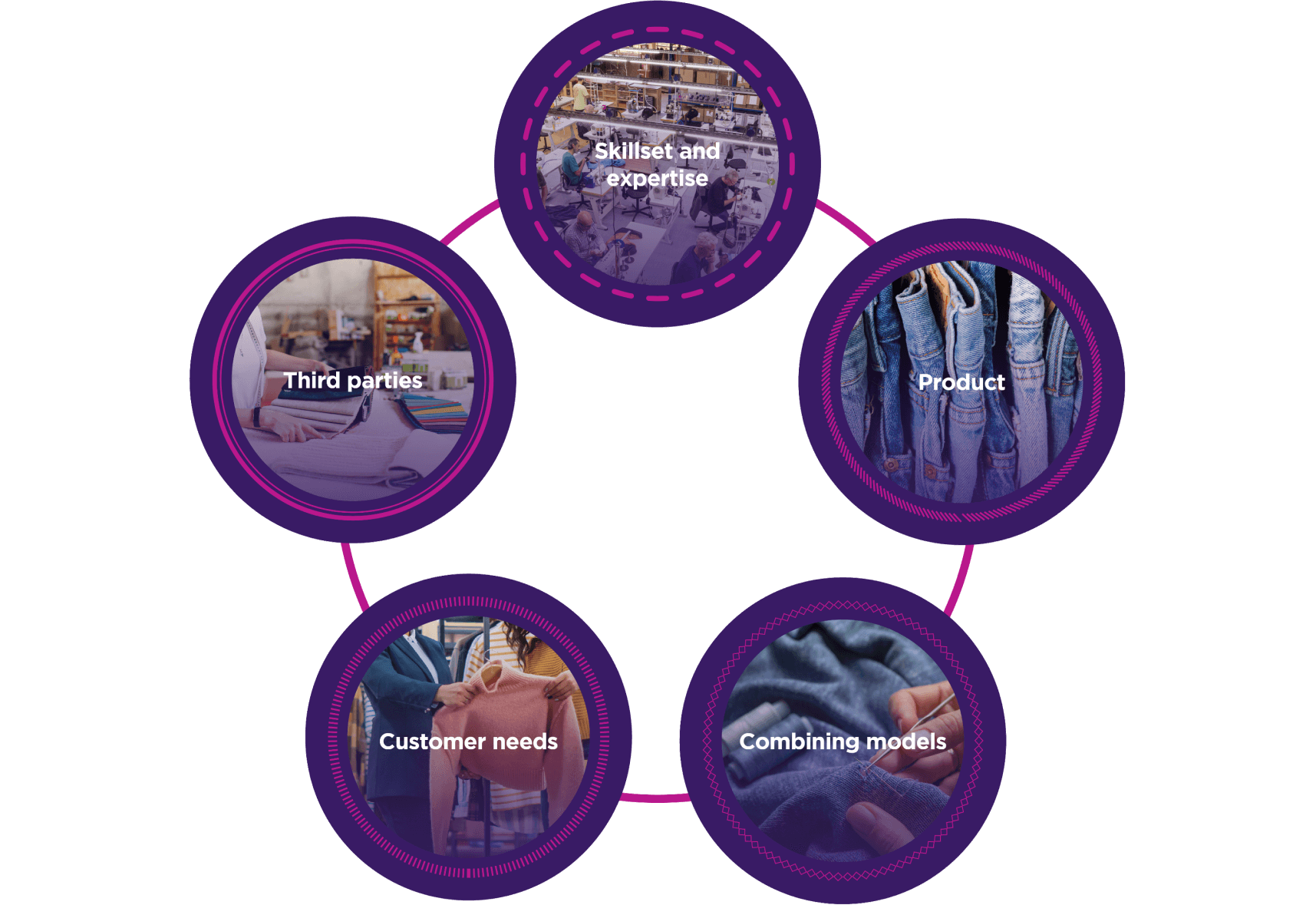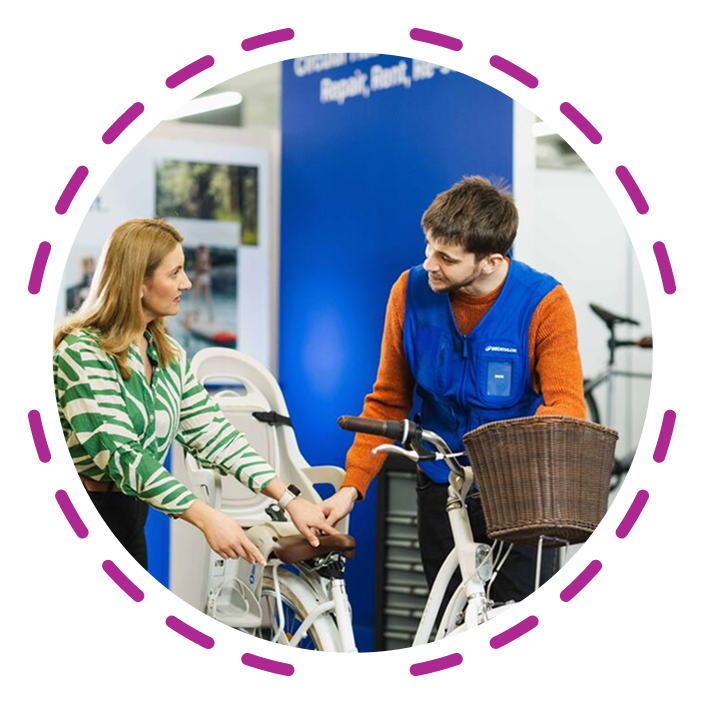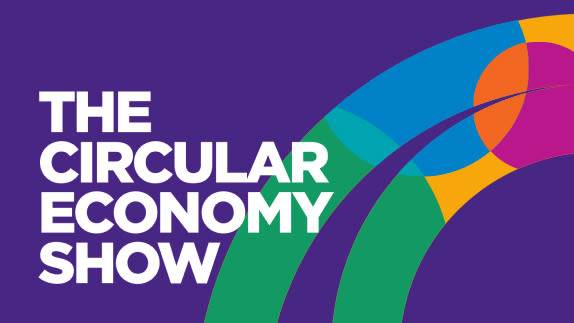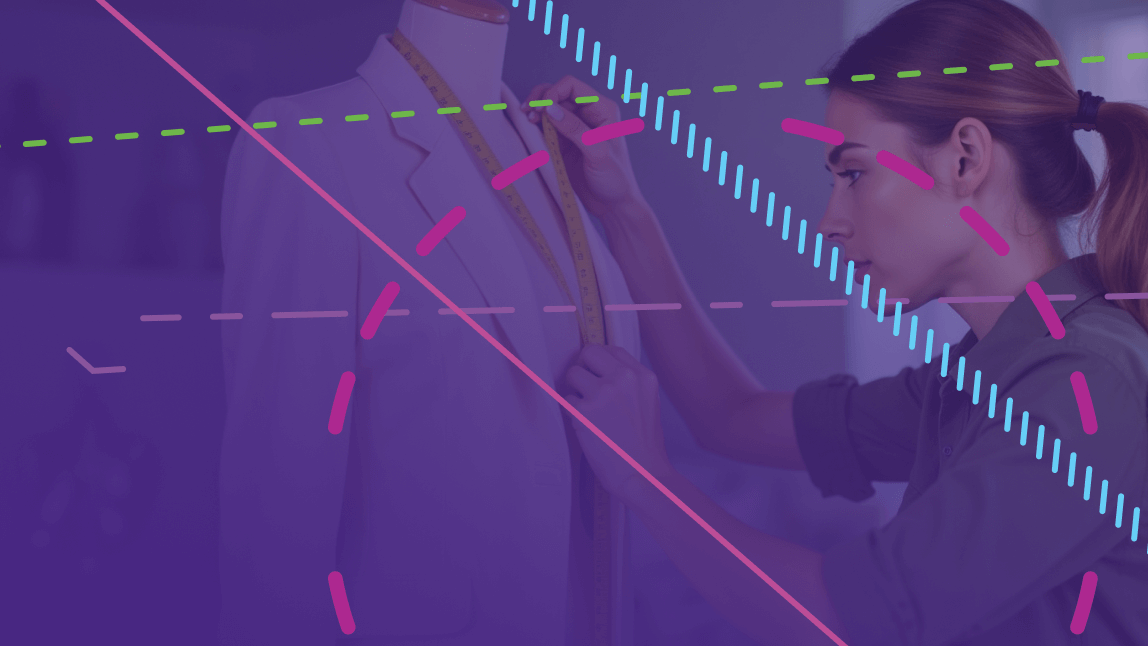This page is part of a guide on scaling circular business models in fashion. The insights here have been developed from analysis of the fashion sector, but will be relevant to other sectors.
To move from pilot to scale, businesses are starting to embed circular business models into their core business strategy.
Circular business models are more likely to succeed when tailored and integrated into a business’s context. At scale, circular business models are an opportunity to drive financial performance and deliver on net-zero targets.
Integrating and gaining internal buy-in for circular business models based on business context and priorities
Getting started:
Consider the key questions you need to answer to design circular business models that drive business value, including organisational skillset and expertise, product type, and customer needs.
Drive and secure buy-in from internal stakeholders across the business, including early engagement with finance teams.
Explore the examples and learn from others, putting this into practice.
Design circular business models to drive business value
You know your business best. You and your colleagues will understand your organisation’s priorities, capabilities, customers, market, products, and innovation appetite.
Explore the five sections below to consider how you might tailor your circular business models:


Skillset and expertise
What capabilities does your organisation already have in-house?
For example, an organisation with skilled craftspeople focusing on heritage design might find repair and remaking to be a natural choice. Alternatively, an organisation with a workforce highly skilled in technology and e-commerce might find an online solution to be the best fit, such as resale.
Tapestry: Over the past two years, Coach’s leather craftspeople have restored, upcrafted, and repaired more than 120,000 bags globally for customers, successfully preserving a heritage in leathercraft. Coach identified that one of the most important ways to reduce the climate impact is to extend the life cycle of their products. Coach's study with Columbia University found that buying a Coach (Re)Loved product can reduce an item’s carbon footprint by 76% compared to buying new. Ultimately, Coach (Re)Loved harnesses the creativity and imagination of the designers and craftspeople involved, while also providing a climate beneficial model.

Zalando: In 2020, Zalando brought pre-owned into the Zalando online store, offering a seamless solution at scale. Offering the Pre-owned category at Zalando bridges the gap between the fun of fashion shopping, freshness and self-expression, and unmatched convenience, as customers can shop both pre-owned and new fashion on the same platform.

Psychology is key to helping the fashion industry transform to have a positive environmental impact. By understanding customer behaviour, businesses, industry actors, and policymakers can design and drive smarter systems, reduce waste, and power lasting, planet-positive change."
Carolyn Mair, Cognitive Psychologist.
Drive and secure buy-in from internal stakeholders
Co-ownership across the business, especially internal finance stakeholders, is critical to articulating holistic financial value and ensuring that circular business models are embedded in organisational strategies, plans, and budgets. Building the business case goes beyond the efforts of sustainability professionals alone.
Read more about the five factors to consider to increase internal buy-in:
Engage your finance team as a priority
Designate a lead for the circular business model outside of the sustainability team
Establish cross-functional steering groups
Secure C-Suite buy-in
Harness the expertise of other teams

Engage your finance team as a priority
By engaging the finance team as a priority, there is increased buy-in for the business case, including embedding core financial metrics of success.
Reformation: Reformation reported that 17% of their business volume in 2023 was made up of resale, vintage and rental, demonstrating the potential to scale up operations. Reformation engaged its finance team at the beginning of the journey. In 2019, Reformation’s partnership with ThredUP uncovered over USD 1.9 million in financial benefits. Reformation was an early case study trialling NYU Stern Center for Sustainable Business ROSI™ Framework to calculate the wider business value. By embedding clear business rationale at the core of the business and engaging the finance function in the process, Reformation has continued to see success and scale in the circular business model offerings.

Designate a lead for the circular business model that sits outside of the sustainability team
By designating a lead outside of the sustainability team, circular business models become more integrated into the core business.
Zalando: Zalando sees the opportunity to further grow their Recommerce offering due to positive customer engagement, and as the secondhand fashion market is also growing at speed. Zalando have, therefore, embedded Recommerce within their broader commercial set-up, alongside other customer propositions like Fashion, Beauty, Sports and Kids. Recommerce is led by a General Manager who has full ownership of, and accountability for, the customer experience, commercial goals and the P&L. The General Manager steers the business with the customer top of mind, creating compelling and convenient solutions for customers who are increasingly interested in the resale space, both as sellers and buyers.
“In order to realise our vision to make Pre-owned on Zalando a truly compelling offering for our customers, we set up a team of commercial experts who are fully dedicated to this mission, whom I am lucky enough to lead. We offer our customers the unique opportunity to both trade in items purchased on Zalando, and shop both Pre-owned and new assortment in one inspiring and convenient experience. For both customers already committed to buying and selling secondhand, and for those wanting to try it for the first time, we offer a safe, trusted and fun shopping experience, which our customers love.”
Alice Marshall, General Manager Zalando Recommerce

Establish cross-functional steering groups
Cross-functional steering groups enable circular business models to maintain strategic alignment and track against ambitions.
Arc’teryx: Since day one, circularity has been built into Arc’teryx’s design DNA: creating durable, hardwearing products that can outlast the hardiest adventures. Over time, this focus has formed an increasingly critical role in shaping the future of the brand: creating durable, repairable products, facilitating resale and creating an ecosystem to enable circular behaviours. With executive sponsorship from its CEO, cross-functional working groups bring together leaders across the organisation at a regular cadence – from finance to design, merchandising to technology and supply chain to brand – sharing insights and challenges to elevate circular business models. Through leadership, circularity has been integrated into Arc’teryx’s long-term strategic plan, with working groups bringing deep expertise and maintaining momentum to bring this work into all levels of the business. Circular economy now forms a key strategic focus for all teams and is deeply embedded into the employee experience at Arc’teryx, working toward a shared vision for the outdoor industry.

Secure C-suite buy-in
Securing buy-in from the C-suite level early in the process sets the long-term direction of the organisation towards a circular economy by embedding circular business models into core strategy and priorities.
H&M Group: H&M Group has outlined circular business models, like resale, as a core activity within its strategy towards decoupling revenue from virgin resource use (p.9). H&M Group Annual and Sustainability Report 2024 includes the importance of additional ventures, including Sellpy, in creating long-term growth.
“Our brands reach diverse customer groups with their own unique offers, while our ventures create additional long-term growth…today, Sellpy is one of Europe’s largest second-hand platforms for fashion, available in 24 markets.“
Daniel Ervér, CEO H&M Group (p.11)

Harness the expertise of other teams
By harnessing the expertise of functions across the business, barriers to scaling circular business models can be overcome, including making repair, rental, resale, and remaking models more desirable for customers.
Decathlon: In 2024, DECATHLON repaired 3 million sports gear and bike products across 1,730 repair workshops. DECATHLON teams are now studying insights from repair programmes to determine how to implement similar strategies for apparel and footwear. As part of this learning journey, DECATHLON takes a cross-functional approach to rapidly innovate proof-of-concept ideas to go from pilot to scale. In these early stages, key barriers often include market readiness, customer behaviour, legislation and infrastructure. Using expertise from teams across retail, supply chain, and digital, DECATHLON aims to gain an in-depth understanding of local markets and rapidly innovate circular business model offerings.
Putting these five measures in place early can support the long-term buy-in and expertise needed to deliver on these critical transformations.

“As business models evolve from linear to circular, the role of marketing expands beyond simply selling a product: It's about shaping new habits. This presents a significant opportunity for marketing teams to take the lead in positioning circular behaviours as aspirational, intuitive, and fundamental to the overall brand experience.”
Lasse Lindqvist, Co-founder of ANDx.
Calling for the necessary transformation through internal and industry-wide action — hear from one of The Fashion ReModel participants, Primark.
“Joining the Ellen MacArthur Foundation’s Fashion ReModel supports our ambition to scale circularity at Primark. We’re proud to back the Foundation’s vision and play our part in driving the shift towards a more circular fashion industry.
There needs to be greater acceleration towards circularity in the fashion industry. We started small with our circularity ambitions but are working to scale this within our business so it can be truly embedded in the way we design and make our clothes in the future. Scaling circularity has taken some time, but we truly believe we can use our scale to help deliver real change for the industry, and this partnership will allow us to push Primark further. Through our work with the Foundation, we continue to explore how we further embed circularity in the business, including pre-loved models.
We know there’s more to do, but we’re committed to taking practical steps forward – and to collaborating across the industry to scale solutions that can drive real change."
Nick Lambert, Head of Circularity, Primark Cares









